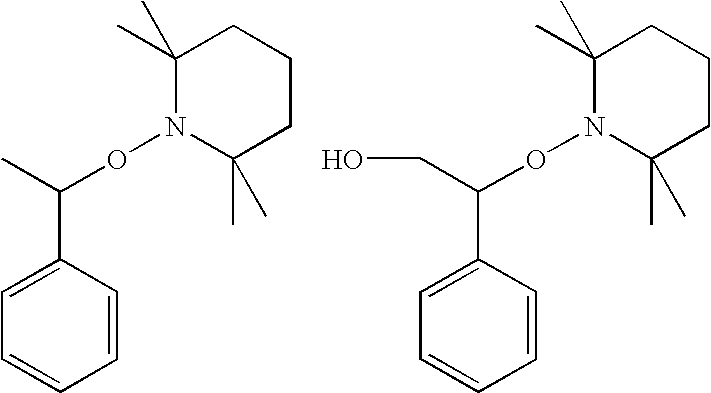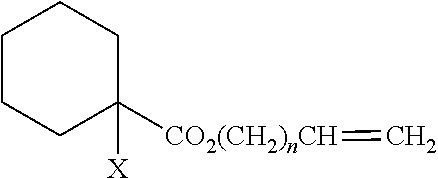Curable composition
a technology of transparent and curable materials, applied in the direction of other chemical processes, coatings, transportation and packaging, etc., can solve the problems of difficult material use, silicone oil bleedout, pollution of the surrounding, etc., and achieve excellent strength, weather resistance, and elongation at break
- Summary
- Abstract
- Description
- Claims
- Application Information
AI Technical Summary
Benefits of technology
Problems solved by technology
Method used
Image
Examples
synthesis example 1
[0354]A 2-liter flask was charged with 8.39 g (58.5 mmol) of cuprous bromide and 112 mL of acetonitrile, and the contents were heated at 70° C. with stirring under a nitrogen stream for 30 minutes. Thereto were added 17.6 g (48.8 mmol) of diethyl 2,5-dibromoadipate and 224 mL (1.56 mol) of n-butyl acrylate, and the mixture was further heated at 70° C. with stirring for 45 minutes. Thereto was added 0.41 mL (1.95 mmol) of pentamethyldiethylenetriamine (hereinafter referred to as “triamine”), and the reaction was thereby started. While continued heating at 70° C. with stirring, 895 mL (6.24 mol) of butyl acrylate was added dropwise intermittently over 160 minutes beginning at 80 minutes after start of the reaction. During this dropping, 1.84 mL (8.81 mmol) of triamine was added. After the lapse of 375 minutes after start of the reaction, 288 mL (1.95 mol) of 1,7-octadiene and 4.1 mL (19.5 mmol) of triamine were added, and the heating at 70° C. with stirring was further continued. At 6...
synthesis example 2
[0358]An alkenyl group-terminated vinyl copolymer [3] was obtained in the same manner as in Synthesis Example 1 except that 3.40 g (23.7 mmol) of cuprous bromide, 47 mL of acetonitrile, 7.80 g (21.7 mmol) of diethyl 2,5-dibromoadipate, 368 mL (2.56 mol) of butyl acrylate, 38 mL (0.41 mol) of methyl acrylate, 77 mL (0.19 mol) of stearyl acrylate, 2.475 mL (11.86 mmol) of triamine, 141 mL of acetonitrile, 58 mL (0.40 mol) of 1,7-octadiene were used.
[0359]A silyl group-terminated n-butyl acrylate / methyl acrylate / stearyl acrylate copolymer (polymer B) was obtained using the copolymer [3] (260 g) obtained above, as well as dimethoxymethylhydrosilane (8.46 mL, 68.6 mmol), methyl orthoformate (2.50 mL, 22.9 mmol) and a platinum catalyst. The copolymer obtained had a number average molecular weight of 23,000 with a molecular weight distribution of 1.3. The average number of the silyl groups introduced per polymer molecule as determined by 1H-NMR spectrometry was about 1.7.
synthesis example 3
[0360]800 g of an allyl ether group-terminated polyoxypropylene of number average molecular weight of about 19,000 was introduced into a pressure-resistant reaction vessel equipped with a stirrer. Methyldimethoxysilane and 1×10−4 [eq / vinyl group] of a chloroplatinate catalyst (chloroplatinate hexahydrate) were then added thereto and the resultant mixture was subjected to reaction for 2 hours at 90° C. to produce a crosslinkable silyl group-containing polyoxyalkylene polymer (polymer C) having 2.1 methyldimethoxysilyl groups, on average, in one molecule.
PUM
| Property | Measurement | Unit |
|---|---|---|
| molecular weight distribution | aaaaa | aaaaa |
| particle size | aaaaa | aaaaa |
| particle diameter | aaaaa | aaaaa |
Abstract
Description
Claims
Application Information
 Login to View More
Login to View More - R&D
- Intellectual Property
- Life Sciences
- Materials
- Tech Scout
- Unparalleled Data Quality
- Higher Quality Content
- 60% Fewer Hallucinations
Browse by: Latest US Patents, China's latest patents, Technical Efficacy Thesaurus, Application Domain, Technology Topic, Popular Technical Reports.
© 2025 PatSnap. All rights reserved.Legal|Privacy policy|Modern Slavery Act Transparency Statement|Sitemap|About US| Contact US: help@patsnap.com



